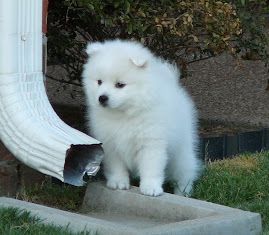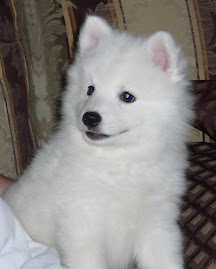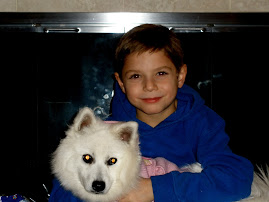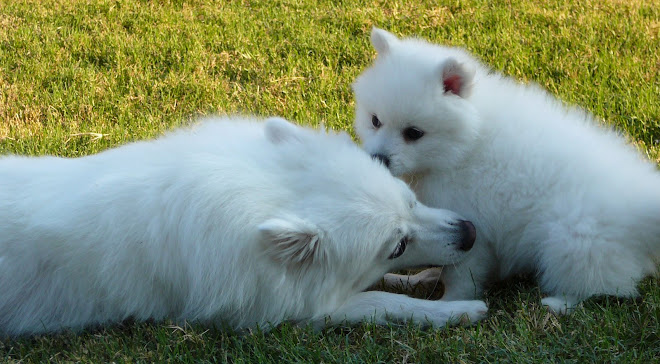
FIRST AID IN THE FIELD (Entry #1 - "Paw Lacerations")

Spring Time Poisons
 Written March 20, 2009
Written March 20, 2009Finally, winter is passé and spring has sprung! The trees are green again, the flowers are in bloom, and pretty soon, you will be working in your gardens and flower beds. Before you make that trip to your local home/garden improvement store to pick out what you will be planting this year, you'll want to make sure the plants are not harmful to the four-legged members of your family. Hopefully, the information provided below will help you make more educated plant choices.
Some of the most common poisonous plans include:
- Lilies (can cause severe kidney damage)
- Sago Palm (can cause vomiting, diarrhea, depression, seizures & liver failure)
- Tulips / Narcissus bulbs (can cause intense gastrointestinal irritation, drooling, loss of appetite, depression of the central nervous system, convulsions and cardiac problems)
- Azaleas / Rhododendron (can cause vomiting, drooling, diarrhea, weakness & depression of the central nervous system, coma and death)
- Oleanders (can cause gastrointestinal tract irritation, abnormal heart function, hypothermia and death)
- Castor Bean (can cause severe abdominal pain, drooling, vomiting, diarrhea, excessive thirst, weakness and loss of appetite, dehydration, muscle twitching, twitchings, seizures, coma and death.)
- Cyclamen (can cause significant gastrointestinal irritation, intense vomiting and death.)
- Kalanchoe (can cause gastrointestinal irritation and cardiac problems)
- Yew (can cause trembling, incoordination, difficulty breathing, gastrointestinal irritation, cardiac failure and death.)
- Amaryllis (can cause vomiting, depression, diarrhea, abdominal pain, hyersalivation, anorexia and tremors.)
- Autumn Crocus (can cause oral irritation, bloody vomiting, diarrhea, shock, multi-organ damage and bone marrow suppression.)
- Chrysanthemums (can cause gastrointestinal upset, drooling, vomiting, diarrhea, depression and loss of coordination.)
- English Ivy (can cause vomiting, abdominal pain, hypersalivation and diarrhea.)
- Pothos (can cause significant mechanical irritation and swelling or the oral tissues and other parts of the gastrointestinal tract.)
- Schefflera (can cause oral irritation, excessive drooling, vomiting, difficulty in swallowing and intense burning and irritation of the mouth, lips and tongue.)
It is important to remember that not only flowers and plants can be extremely toxic to your pets. Even some mulch can be harmful and potentially fatal. A fairly new brand of mulch, called Cocoa Mulch (sold by many garden supply stores, as well as Home Depot and Target) is manufactured by Hershey's and is known for is pleasant chocolaty smell. The smell is not only attractive to people, but to dogs, as well. The danger here is that this mulch, which is made from cocoa bean shells and contains Theobromine, which is fatally toxic to pets. Unfortunately, according to Dogster.com and Snopes.com, there have already been many pet deaths due to the ingestion of this particular type of mulch.
Remember, this blog contains only a short list of dangerous plants. For a more complete, searchable list, click this link (http://www.aspca.org/pet-care/poison-control/plants/). You will be directed to the ASPCA's poison control website.
If you are diligent in your efforts to ensure your yard does not contain toxic dangers, you and your pet will have a fun and safe playground to enjoy all spring and summer long!
TEACHING BASIC COMMANDS – ENTRY #4 (“STAY”) - Part 2
Written March 14, 2009
Now that you have been using the sit-stay command for a while, let's try an out-of-sight stay. Teaching your dog to stay put even when you are not visible can be tough for your little guy to learn. Dogs, like small children, often think we don't know what is going on when we can't see them and they can't see us. This command can be even harder for dogs who want to be at their owner's side every minute of every day. As such, it is important to think in terms of "baby steps" when working with this command.
First, put your dog in the "sit" position. Next, use the hand signal for the "stay" command*, as well as the word "STAY". Next, hold the treat right above your dog's nose. Your dog will naturally look up. This is OK. Keep the treat in the same place while you slowly walk a full circle around your dog. Once you have completed the circle (and your dog has not moved his bottom from the floor), give your dog the treat you were holding above his nose.
After you had done this a few times and you are confident that your dog understands the concept (i.e., your dog is staying put while you walk around him), slowly increase the size of your circle. Eventually, using this concept, you should be able to put your dog in a successful sit-stay in the center of a room, while you walk the full circumference inside the room. Every time you come full circle and your dog has not moved, be sure to give him a treat.
Once your dog has mastered this circle sit-stay method. Try walking through an open or a glass door for a second or two. Slowly increase the number of seconds you stay on the other side of the door. Again, remember to give your dog a treat at the end of each successful "Stay" command. As your dog progresses, you will eventually be able to close the door and/or even leave a room, all the while remaining confident that your dog has not broken his sit-stay command. Also, Remember not to work with your dog for longer than about 15 minutes at a time. You don't want your pooch to get restless, since focus is needed when training.
Do NOT abuse your power. Some dogs are simply not capable of remaining in a "Stay" position for longer than 15 minutes. For other dogs, remaining in a "Stay" position for 30 minutes or even longer is nothing. Some dogs may go to sleep during this exercise and that is fine - as long as he stays put. Know your dog's limits and ALWAYS reward with lots and lots of praise. Let your little buddy know how pleased you are with his progress.
Now, on a separate note, I would be remiss if I did not mention that our youngest little girl, Ju-Ju, graduated her Beginner's Obedience Training class last Thursday. Michael and I are both VERY proud of her. She is such a smart little girl!

*If you have not yet taught your dog the "STAY" command, see the blog entry entitled: Teaching Basic Commands - Entry #3 ("Stay") - Part 1
Dealing with Separation Anxiety
No doubt you've heard about the havoc a dog with Separation Anxiety ("SA") can reek on your home, not to mention the horrors that your furry loved-one suffers psychologically. According to Claws & Paws Veterinary Hospital, U.S. veterinary practices estimate that approximately 14% of canine patients exhibit one or more signs of SA. This behavioral disease is second only to aggression. The good news is that separation anxiety is a treatable disorder. However, to learn how to help your dog deal with his complex, your first have to understand what causes this syndrome and its origins.
"When separated from their social group, most pups whine, bark or howl. These sounds are referred to as distress vocalizations." says Peter J. Volmer, from the Animal Care Center Veterinary Clinic. "In the wild, these sounds increase the chances that a puppy will be reunited with the pack. If a pup’s movement is restrained while it is isolated, it will respond with escape behaviors such as digging, thrashing about, and chewing. These behaviors have obvious benefits for survival."
According to Peter Volmer, many pet owners inadvertently elicit these behaviors by placing a young puppy in a barricaded kitchen or other unoccupied area of the house. Sometimes these owners provide a ticking clock, a radio, or a hot water bottle to “comfort” the animal. This entire procedure is unnecessary at the least, and can harm the puppy psychologically and physically if emotional behaviors indicating stress are allowed to persist or worsen. This effect can lessen if the puppy's sleeping crate is placed in a bedroom with a family member.
However, it is important to note that SA can also occur in adolescent dogs, especially those adopted from a shelter; middle-aged dogs, though that is less common; and in older dogs. The theory regarding older dogs with SA is that as dogs age, they may lose sensory perception , such as hearing and sight, and thus they become more dependent on their owners, resulting in possible anxiety when they are separated or their owners are out of view.
In older dogs, prolonged and constant human contact is frequently seen in cases of SA. Many dogs are so strongly attached to their owners that they will follow them from room to room to maintain close proximity.
Signs of SA can range from mild to severe:
Distress vocalization—howling, barking, whining
Inappropriate elimination—urination, defecation
Destructive behavior—chewing, digging
Anorexia/ “depression” or inactivity
Psychosomatic/medical consequences—excessive licking of haircoat, pacing, circling
Hyperattachment—excessive greeting behavior, constant pestering of owner
Hypersalivation
The behaviors associated with separation anxiety often occur within a short period of time after the animal is left alone, a unique feature which distinguishes separation anxiety from other behavioral disorders. Please note that a thorough history and physical examination (including blood tests) are needed to definitively diagnose separation anxiety and rule out other medical or behavioral differential diagnoses.
SA can be treated by both medical intervention and behavioral modification/training. The course of treatment should be determined on a case by case basis depending upon your dog’s response to the therapy/treatment first chosen. Improvement may be seen within a few days, and typically is observed within one month or less of treatment. A standard length of treatment duration is two months, with some dogs needing longer treatment times. Because dogs with SA are truly suffering and can do real harm to themselves, treatment is the only humane option.
Behavioral modification techniques of treatment are based upon the principles of desensitization and counter-conditioning. This training is not hard, nor does it take very long to complete each session. One popular technique is detailed below*
Step #1: Practice leaving your dog alone for short periods of time. Pick up your keys and leave for 1 minute.
Step #2: Gradually increase the amount of time you stay away. This will accustom your dog to your absence
Step #3: Avoid overly emotional good-byes and greetings. Instead, pat your dog on the head and offer a quick good-bye or hello
Step #4: Keep your dog confined in a safe area while you are away. Be sure to leave a bowl of water and plenty of chew toys.
Step #5: Exercise your dog for an hour each day in places other than your yard or home. This helps your dog feel comfortable in other locations and lets her blow off steam.
Step #6: Praise your dog often to build self-confidence, rather than punishing her for exhibiting frightened behaviors. Punishment only increases anxiety and makes the situation worse.
According to Paws & Claws, before beginning treatment, it is important to identify which behaviors are to be assessed and what level of progress is expected. While most dogs do respond well to treatment for separation related anxiety, treatment failures do occur. Signs of separation anxiety may return with changes to the dog’s environment or routine. Common precipitating factors include marriage, moving to a new house, a new baby, and changes in schedules (children going back to school or a new job with different hours). In such instances, additional treatment may be needed.
In all cases of canine separation anxiety, any form of reprimand or punishment is contra-indicated and may actually increase the dog’s anxiety.
 * Technique taken from ehow.com
* Technique taken from ehow.com












